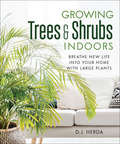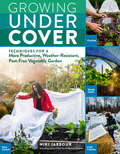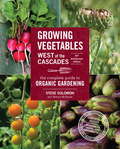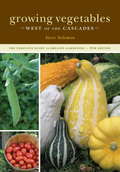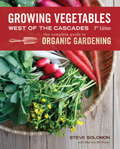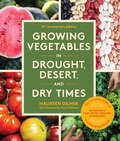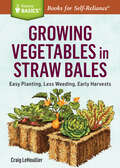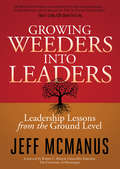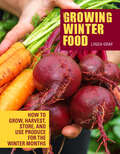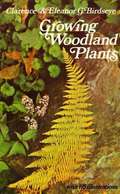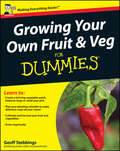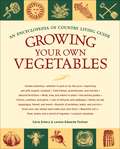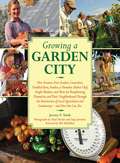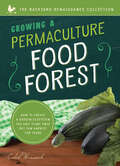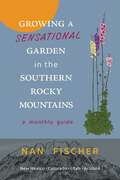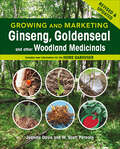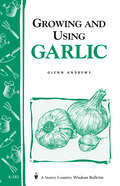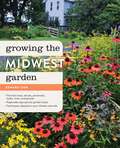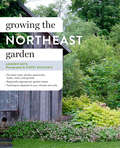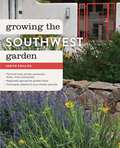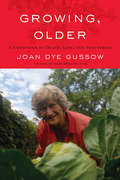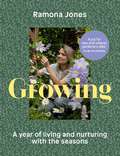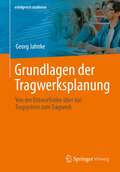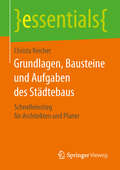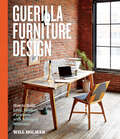- Table View
- List View
Growing Trees & Shrubs Indoors: Breathe New Life into Your Home with Large Plants
by D. J. Herda&“Distills a lifetime of plant experience into easy-to-follow instruction, giving an amateur like me the confidence to green my home for health.&” —Paula Baker-LaPorte, coauthor of Prescriptions for a Healthy House Some of the most polluted places on earth are where we spend 90% of our time: inside our homes. Science is continually uncovering more effective ways of improving the quality of our environment, and plants—specifically indoor trees and shrubs—are at the top of this list. Growing trees and shrubs indoors might seem like a monumental challenge, but it&’s no different than growing any plants indoors. Written by master gardener DJ Herda, Growing Trees and Shrubs Indoors is a definitive guide on what makes these plants special and all the tips and tricks you need to help them survive and flourish in an indoor environment. It covers how they: · Rid your environment of airborne pollutants · Beautify your home · Help you to live a longer, healthier, happier life. An explosive introduction into the wellness scene, Growing Trees and Shrubs Indoors is for those with a keen interest in gardening, health, and science, offering an entirely new way of promoting human wellness—by creating beautiful, enjoyable surroundings. &“A fascinating, encyclopedic compendium dealing with the nature and care of trees and shrubs.&” —Arnold M. Ludwig, author of King of the Mountain &“Covers everything from watering needs and light requirements to propagation to keeping costs down, all in an effort to help you create a verdant home that has the health benefits of being outside.&” —Deanna Duke, author of The Non-Toxic Avenger &“Clearly written and beautifully illustrated. It&’s a real eye-opener!&” —Phillip Adcock, author of Master Your Brain
Growing Under Cover: Techniques for a More Productive, Weather-Resistant, Pest-Free Vegetable Garden
by Niki JabbourIncreasingly unpredictable weather patterns and pest infestations are challenging today&’s vegetable gardeners. But best-selling author Niki Jabbour has a solution: Growing Under Cover. In this in-depth guide, Jabbour shows how to use small solutions like cloches, row covers, shade cloth, cold frames, and hoophouses, as well as larger protective structures like greenhouses and polytunnels, to create controlled growing spaces for vegetables to thrive. Photographed in her own super-productive garden, Jabbour highlights the many benefits of using protective covers to plant earlier, eliminate pests, and harvest a healthier, heartier bounty year round. With enthusiasm, inventive techniques, and proven, firsthand knowledge, this book provides invaluable advice from a popular and widely respected gardening authority. This publication conforms to the EPUB Accessibility specification at WCAG 2.0 Level AA.
Growing Vegetables West of the Cascades, 35th Anniversary Edition
by Steve Solomon Marina McshaneCompletely revised from cover to cover, this is the 35th anniversary release of Growing Vegetables West of the Cascades, the bible to organic vegetable gardening in the Pacific Northwest. Now in its seventh edition, the book has been thoroughly updated and includes a new formula for complete organic fertilizer and how to tweak it for a variety of different soil conditions, how-to sections for herbs and ornamental plants, new organization for better usability, updated sources for appropriate seed suppliers, and information about natural pest controls.From the Trade Paperback edition.
Growing Vegetables West of the Cascades, 6th Edition
by Steve SolomonThis is the updated 6th edition of Growing Vegetables West of the Cascades, which has evolved from a self-published pamphlet to the master guide to organic vegetable gardening over the past 28 years. Steve Solomon, who was a founder of the Territorial Seed Company, was one of the early proponents of organic gardening, and the first to codify and refine the best practices of small-plot vegetable gardening in the Pacific Northwest. The approaches to understanding and preparing soils, composting, chemical-free fertilizers, efficient uses of water, and garden planning are universal to any climate or region. Solomon gets specific in his extensive advice on growing specific crops in the gentle maritime Northwest climate. This update includes his latest findings on seed sources, refinements in growing and cultivation techniques, and other organic gardening best practices. Growing Vegetables West of the Cascades lays out the principles, but the author advocates that readers think for themselves and grow their gardens as they see fit.
Growing Vegetables West of the Cascades, Updated 6th Edition
by Steve SolomonNow in a special updated 6th edition with a new formula for complete organic fertilizer, this complete guide to organic vegetable gardening addresses issues of soil, seeds, compost, and watering. Growing Vegetables West of the Cascades evolved from a self-published pamphlet to the master guide to organic vegetable gardening over the past 35 years. Steve Solomon, who founded the Territorial Seed Company, was one of the early proponents of organic gardening, and the first to codify and refine the best practices of small-plot vegetable gardening in the Pacific Northwest. The approaches to understanding and preparing soils, composting, chemical-free fertilizers, efficient uses of water, and garden planning are universal to any climate or region. Solomon gets specific in his extensive advice on growing specific crops--from tomatoes and beans to kale and turnips--in the gentle maritime Northwest climate. He lays out the principles, but advocates that readers think for themselves and grow their gardens as they see fit.
Growing Vegetables in Drought, Desert & Dry Times
by Maureen GilmerHere is the definitive guide to growing healthy organic vegetables without wasting our precious water resources! This incredibly timely book will give dedicated home gardeners the know-how to grow delicious produce in dry times, focusing on four different low-water conditions in the western United States: voluntary water conservation, drought, and both high and low desert. Using modern techniques, as well as tips and stories from native traditions ranging from the southwestern United States to the Middle East, this guide offers the best of ancient wisdom and the newest innovations in conservation, and includes varietal recommendations and a seasonal crop guide.From the Trade Paperback edition.
Growing Vegetables in Straw Bales: Easy Planting, Less Weeding, Early Harvests. A Storey BASICS® Title (Storey Basics)
by Craig LeHoullierStraw bale gardening is an inexpensive, low-maintenance way to grow a bounty of food in a small space. All you need is a bale of straw, some fertilizer, and your favorite vegetable seeds! Craig LeHoullier’s step-by-step instructions show you how to do everything from sourcing the straw and setting up your bale to planting, dealing with weeds and pests, and harvesting.
Growing Weeders Into Leaders: Leadership Lessons from the Ground Level
by Jeff McManusOne of America&’s most accomplished landscaping professionals reveals his methods for cultivating greatness. Nowadays, greatness tends to be measured by shortest or longest times, highest heights, medals won, honors given. But as Aristotle taught us, greatness is what we can do every day, without recognition or reward, for the satisfaction that comes from meeting the challenge, creating a team, and overcoming the odds. Under Jeff McManus&’s leadership as Director of Landscape Services, the Ole Miss campus has won professional awards—and been cited by Newsweek and Princeton Review as America&’s &“most beautiful campus.&” In Growing Weeders into Leaders, he relates the principles behind his team&’s success. It is an entertaining and thoughtful look into the hearts and the workday lives of ordinary people who tapped into their inner greatness in pursuit of a vision. Creating one of America&’s most beautiful college campuses at the University of Mississippi did not happen overnight and, inside these pages, McManus describes the joys, the defeats, the brilliant problem-solving and the best laid plans that are proven worthless . . . until the bigger picture appears. This is the bigger picture as viewed from the ground level—taking you through the practical applications of empowering people to experience not only what it means to grow outstanding landscapes, but also to grow greatness in themselves and encourage it in others. &“A straightforward approach to problem-solving and methods to grow individuals into a team.&” —Susanne Woodell, CGM Historic Gardens Manager, Biltmore
Growing Winter Food: How to Grow, Harvest, Store, and Use Produce for the Winter Months
by Linda Gray&“The essential gardening guide for those who want to enjoy their garden&’s output all year round&” (Modern Mississauga Magazine).DON&’T LIMIT YOUR GARDEN&’S HARVEST TO SUMMER! Discover the joys of growing and harvesting fresh produce that you can eat all winter long with this essential guide from home and garden expert Linda Gray. Growing Winter Food will show you how to enjoy a delicious array of healthy roots, legumes, green vegetables, herbs, and fruits long after the thermometer—and the snow—have fallen. The author provides detailed cultivation advice for each crop, along with nutritional information, recipe ideas, and storage suggestions. How to choose, grow, and preserve crops so you&’ll have fresh vegetables over the winterEasy-to-follow instructions for sowing, maintenance, harvesting, and general gardening techniques for specific cropsAll of the basic techniques you need to know, from preparing the soil to using containers to dealing with pests and diseasesStorage options and recipe ideas to help you make the very best use of your crops&“Lisa&’s practical organization and &“start where you are style&” take the intimidation out of growing your own food, and then she provides a few ways in each chapter to make your work into a delicious meal. It&’s enough to encourage any would-be gardener to get to digging.&” —Stephanie Burt, food writer and host of The Southern Fork podcast&“I live in a region with four distinct seasons so Growing Winter Food is THE book to help me plan my two favorite hobbies: gardening and cooking. There&’s no better feeling that seeing a larder packed, year-round, with the fruits (and veggies) of my own labor.&” —Natalie Bovis, The Liquid Muse, author of Edible Cocktails: Garden To Glass
Growing Woodland Plants
by Clarence Birdseye Eleanor G. BirdseyeThe authors explain the interrelationships of trees, wildflowers, ferns, bacteria, and the soil of woodlands; suggest ways of preparing both large and small wildflower gardens; and describe when, where, and how to gather woods plants. Includes detailed information on over 200 wildflowers and ferns. 195 illustrations.
Growing Your Own Fruit and Veg For Dummies
by Geoff StebbingsSave money and eat fresh with this hands-on guide to home-growingGrowing you own produce is the only way to enjoy delicious, garden-fresh fruit and veg all year round. This practical manual gives you the lowdown on everything from finding the right tools and choosing which plants to grow, to nurturing your crops and bringing in your first harvest. The easy-to-follow advice will help you get started straight away and become a confident and successful kitchen gardener.* Get going with growing - discover which plants are best for you and how to make the most of your outdoor space* Prepare your plot - learn how to set up and maintain healthy beds for your fruit and vegetables* Grow tasty veg - choose your favourite veggies from asparagus and broccoli to courgettes, sweet corn and many more* Grow your own fruit salad - get quick results from fast-growing berries and learn to nurture slow-growing tree fruit and exotic greenhouse produce
Growing Your Own Vegetables: An Encyclopedia of Country Living Guide
by Carla Emery Lorene Edwards ForknerDrawn from and expanded on the bestselling Encyclopedia of Country Living, this is a complete manual for setting up a vegetable garden--whether it's just a few rows of lettuce or a year-round field that produces enough for a whole family to eat. This book is informed by years of hands-on experience and the wisdom gathered from a generation of homesteaders and small farmers. Starting with planning the garden (plot size, seasonal considerations, getting the most from a small plot) and laying it out (rows, beds, plowing), this book addresses the planning and growing issues for all North American climate zones. Gardeners need to understand (and love) their soil, and the Growing Your Own Vegetables explains it in simple terms, with advice on composting and testing for contamination (so important since this is going to be your food source!). Carla Emery was a very early advocate of gardening without chemical fertilizers, so the approach here is organic all the way. The large part of the book is the crop-by-crop guide to planting, cultivating, and harvesting the delicious vegetables we love to ear: onions, leafy greens, stems and flowers (rhubarb, artichoke, broccoli), roots (spuds, radishes, jicama), grasses & grains (just imagine: your own wheat field!), legumes, gourds, and the nightshade family (that would be tomatoes, peppers, eggplant).
Growing a Garden City: How Farmers, First Graders, Counselors, Troubled Teens, Foodies, a Homeless Shelter Chef, Single Mothers, and More are Transforming Themselves and Their Neighborhoods Through the Intersection of Local Agriculture and Community
by Bill Mckibben Chad Harder Sepp Jannotta Jeremy N. SmithFifteen people--plus a class of first graders--tell how local food, farms, and gardens changed their lives and their community...and how they can change yours, too. Growing a Garden City includes: Fifteen first-person stories of personal and civic transformation from a range of individuals, including farmers and community garden members, a low-income senior and troubled teen, a foodie, a food bank officer, and many more Seven in-depth "How It Works" sections on student farms, community gardens, community supported agriculture (CSA), community education, farm work therapy, community outreach, and more Detailed information on dozens of additional resources from relevant books and websites to government programs and national non-profit organizations Over 80 full-color photographs showing a diverse local food community at home, work, and play Read Growing a Garden City to: Learn how people like you, with busy lives like yours, can and do enjoy the many benefits of local food without having to become full-time organic farmers Gain the information you need to organize or get involved in your own "growing community" anywhere across the country and around the world
Growing a Permaculture Food Forest: How to Create a Garden Ecosystem You Only Plant Once But Can Harvest for Years (Backyard Renaissance)
by Caleb WarnockPlanting your own garden can cut down your grocery bill, but few people have the time to cultivate a big harvest every year. Self-sufficiency expert Caleb Warnock shares his expertise in creating a permaculture food forest: a garden that you plant once and then leave in the hands of Mother Nature for years to come. Best of all, this natural, sustainable, and low-maintanance garden can succeed in any climate, and Growing a Permaculture Food Forest can show you how.This compact guidebook includes:Lists of the best flowers & herbs for food forestsWild edibles for food forestsWhat NOT to plantSustainable harvesting, andSo much more!Seasonal planting and constant weeding are things of the past! With a permaculture food forest, you can feed your family with homegrown vegetables without all the fuss.
Growing a Sensational Garden in the Southern Rocky Mountains: A Monthly Guide (New Century Gardens and Landscapes of the American Southwest)
by Nan FischerIn this month-by-month guide to home gardening in Northern New Mexico and the Southern Rocky Mountains, Nan Fischer offers expert advice on composting, mulching, soil improvements, cold-frame planting for the extension of the growing season, hardy plant selection for the Rocky Mountains, and the wise use of small quantities of water for both ornamental and vegetable gardening at a small, residential garden scale.From planning in winter to sowing in spring and harvesting food and flowers throughout the seasons, Growing a Sensational Garden in the Southern Rocky Mountains: A Monthly Guide will help you plan and grow a successful garden in the challenging conditions of the Intermountain West. Whether you&’re a novice gardener, a grower from another area, or a seasoned gardener from the region, you&’ll find this monthly guide invaluable when creating a beautiful garden that will overflow with vegetables, herbs, flowers, and more. Note-taking pages are included at the end of each month to get you started on a garden journal that is sure to become a personalized, treasured resource.
Growing and Marketing Ginseng, Goldenseal and other Woodland Medicinals
by W. Scott Persons Jeanine DavisThe most comprehensive, truly practical guide to the cultivation of woodland botanicals Not all saleable crops are dependent on access to greenhouses or sun-drenched, arable land. Shade-loving medicinal herbs can be successfully cultivated in a forest garden for personal use or as small-scale cash crops. Growing and Marketing Ginseng, Goldenseal and other Woodland Medicinals is a complete guide to these increasingly popular botanicals, aimed at aspiring and experienced growers alike.In this fully revised and updated edition, authors Jeanine Davis and W. Scott Persons show how more than a dozen sought-after native species can generate a greater profit on a rugged, otherwise idle woodlot than just about any other legal crop on an equal area of cleared land. With little capital investment but plenty of sweat equity, patience, and common sense, small landowners can preserve and enhance their treed space while simultaneously earning supplemental income. Learn how to establish, grow, harvest, and market:Popular medicinal roots such as ginseng, goldenseal, and black cohosh;Other commonly used botanicals including bloodroot, false unicorn, and mayappleThe nutritious wild food, ramps, and the valuable ornamental galax.Packed with budget information, extensive references, and personal stories of successful growers, this invaluable resource will excite and inspire everyone from the home gardener to the full-time farmer. Jeanine Davis is an associate professor and extension specialist with North Carolina State University. Her focus is helping farmers diversify into new crops and organic agriculture. W. Scott Persons is the author of American Ginseng: Green Gold and an expert in growing and marketing wild-simulated and woods-cultivated ginseng.
Growing and Using Garlic: Storey's Country Wisdom Bulletin A-183 (Storey Country Wisdom Bulletin Ser.)
by Glenn AndrewsSince 1973, Storey's Country Wisdom Bulletins have offered practical, hands-on instructions designed to help readers master dozens of country living skills quickly and easily. There are now more than 170 titles in this series, and their remarkable popularity reflects the common desire of country and city dwellers alike to cultivate personal independence in everyday life.
Growing the Midwest Garden: Regional Ornamental Gardening (Regional Ornamental Gardening Series)
by Edward LyonPart of the Timber Press Regional Ornamental Gardening book series, this book is ideal for home gardeners in Illinois, Indiana, Iowa, Kansas, Michigan, Minnesota, Missouri, Nebraska, North Dakota, Ohio, South Dakota, Wisconsin, southern Ontario, southern Manitoba, and southeastern Saskatchewan.
Growing the Northeast Garden: Regional Ornamental Gardening (Regional Ornamental Gardening Series)
by Andrew Keys Kerry MichaelsPlant selection and garden style are deeply influenced by where we are gardening. To successfully grow a range of beautiful ornamental plants, every gardener has to know the specifics of the region’s climate, soil, and geography. Gardeners in the northeast are lucky—the regular summer rain, gorgeous summer blooms, and stunning fall color make it an ideal place to garden. But there are drawbacks, like hot and humid summers, bitterly cold winters, and mosquitos. TThe practical and beautiful Growing the Northeast Garden starts with a comprehensive overview of the weather and geography of the area, along with regionally specific advice on zones, microclimates, soil, pests, and maintenance. Profiles of the best trees, shrubs, perennials, annuals, and bulbs offer hundreds of plant suggestions, along with complete information on growth and care.
Growing the Southwest Garden: Regional Ornamental Gardening (Regional Ornamental Gardening Series)
by Judith PhillipsPlant selection and garden style are deeply influenced by where we are gardening. To successfully grow a range of beautiful ornamental plants, every gardener has to know the specifics of the region’s climate, soil, and geography.Growing the Southwest Garden, by New Mexico-based garden designer Judith Phillips, is a practical and beautiful handbook for ornamental gardening in a region known for its low rainfall and high temperatures. With more than thirty years of experience gardening in the Southwest, Phillips has created an essential guide, featuring regionally specific advice on zones, microclimates, soil, pests, and maintenance. Profiles of the best plants for the region include complete information on growth and care.
Growing, Older
by Joan Dye GussowMichael Pollan calls her one of his food heroes. Barbara Kingsolver credits her with shaping the history and politics of food in the United States. And countless others who have vied for a food revolution, pushed organics, and reawakened Americans to growing their own food and eating locally consider her both teacher and muse. Joan Gussow has influenced thousands through her books, This Organic Life and The Feeding Web, her lectures, and the simple fact that she lives what she preaches. Now in her eighties, she stops once more to pass along some wisdom-surprising, inspiring, and controversial-via the pen. Gussow's memoir Growing, Older begins when she loses her husband of 40 years to cancer and, two weeks later, finds herself skipping down the street-much to her alarm. Why wasn't she grieving in all the normal ways? With humor and wit, she explains how she stopped worrying about why she was smiling and went on worrying, instead, and as she always has, about the possibility that the world around her was headed off a cliff. But hers is not a tale, or message, of gloom. Rather it is an affirmation of a life's work-and work in general. Lacking a partner's assistance, Gussow continued the hard labor of growing her own year-round diet. She dealt single-handedly with a rising tidal river that regularly drowned her garden, with muskrat interlopers, broken appliances, bodily decay, and river trash-all the while bucking popular notions of how "an elderly widowed woman" ought to behave. Scattered throughout are urgent suggestions about what growing older on a changing planet will call on all of us to do: learn self-reliance and self-restraint, yield graciously if not always happily to necessity, and-since there is no other choice-come to terms with the insistence of the natural world. Gussow delivers another literary gem-one that women curious about aging, gardeners curious about contending with increasingly intense weather, and environmentalists curious about the future will embrace.
Growing: A year of gardening wisdom with simple monthly projects
by Ramona JonesEscape into Ramona's garden, find peace within these pages.A love letter, and gentle guide, to the power of nurturing – flora, fauna and yourself – in whatever outdoor space you have, be it a plot, patch or pot.Each season brings self-care lessons, glimmers of joy and growing opportunities. Spring is a time of reawakening, summer is a time of generosity, autumn brings transformation and winter invites us to slow down.With simple projects and garden jobs organised by month, this is a practical guide for new and established gardeners alike, framed by Ramona's diary-style reflections.-“Over the years, I’ve found solace in gardening, which has allowed me to discover who I truly am. If my mental health feels turbulent, the seasonal rhythm in the garden is a predictable and reassuring constant. Through this book I hope to help you nurture your personal journey through the act of gardening. If you have never gardened before and are feeling intimidated at the thought of getting started, this book will give you permission to begin.” Ramona Jones
Grundlagen der Tragwerksplanung: Von der Entwurfsidee über das Tragsystem zum Tragwerk (erfolgreich studieren)
by Georg JahnkeDieses Lehrbuch der Tragwerksplanung vermittelt Studierenden der Architektur, der Innenarchitektur und des Produktdesigns das essentielle Wissen zu Statik, Tragsystemen und Tragkonstruktionen, das beim Entwurf und der Planung erforderlich ist um ein in sich stimmiges und funktionierendes Gebäude oder Produkt zu konzipieren.Theoretische Grundlagen werden mit zahlreichen praktischen Übungen und Aufgaben kombiniert und immer wieder Bezüge zur Praxis hergestellt. Wissenstests am Ende eines Kapitels vertiefen das Wisssen und regen zur Reflexion an.Das Lehrbuch erscheint in der Springer Vieweg Reihe "erfolgreich studieren".
Grundlagen, Bausteine und Aufgaben des Städtebaus: Schnelleinstieg für Architekten und Planer (essentials)
by Christa ReicherChrista Reicher gibt einen Überblick über die Grundbegriffe und die historischen Phasen des Städtebaus sowie unterschiedliche Theorien. Das städtische Gefüge setzt sich aus verschiedenen Bausteinen und Nutzungen zusammen, die erläutert und in ihrer Bedeutung für qualitätsvollen Städtebau eingeschätzt werden. Die verschiedenen Philosophien beim städtebaulichen Entwerfen als produkt- und prozessorientierte Herangehensweisen werden dargestellt. Eine Aufbereitung der aktuellen Aufgabenfelder illustriert die Relevanz von Städtebau in der Planungspraxis, der Lehre und der Forschung.Die Autorin: Christa Reicher ist Professorin und Leiterin des Lehrstuhls und Instituts für Städtebau an der Fakultät für Architektur der RWTH Aachen. Sie ist außerdem Gründerin eines Planungsbüros mit Sitz in Aachen und Dortmund.
Guerilla Furniture Design: How to Build Lean, Modern Furniture with Salvaged Materials
by Will HolmanBuild stylish and functional furniture from salvaged materials. This innovative guide presents dozens of strategies for upcycling scrap cardboard, metal, plastic, or wood into dependable shelving units, sturdy tables, and fun lamps. With directions for 35 easy and inexpensive projects that include a Cardboard Cantilever Chair, a License Plate Bowl, a Conduit Coatrack, and much more, you’ll be inspired to start filling your home with unique high-style furniture that makes sense for both your wallet and the environment.
